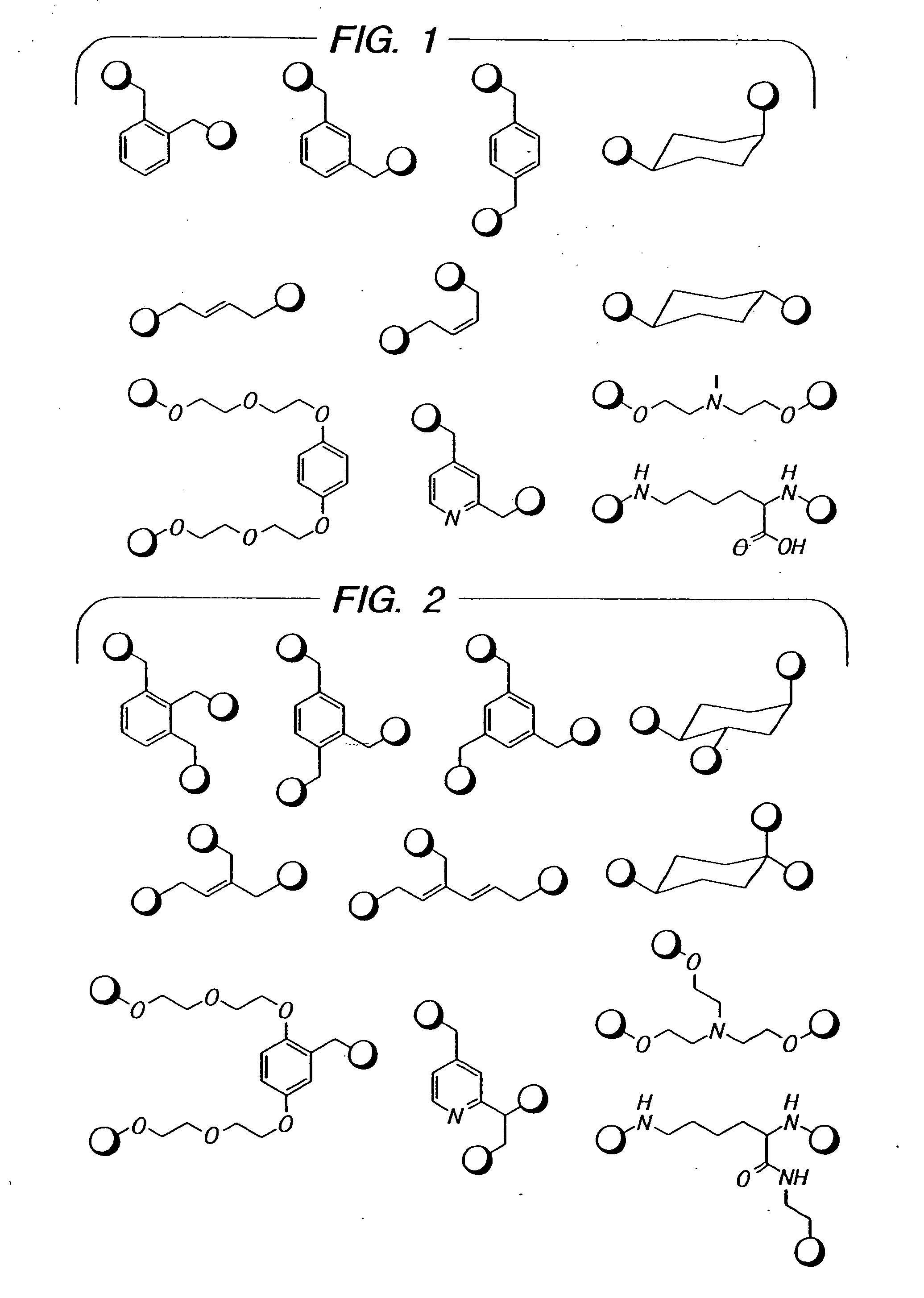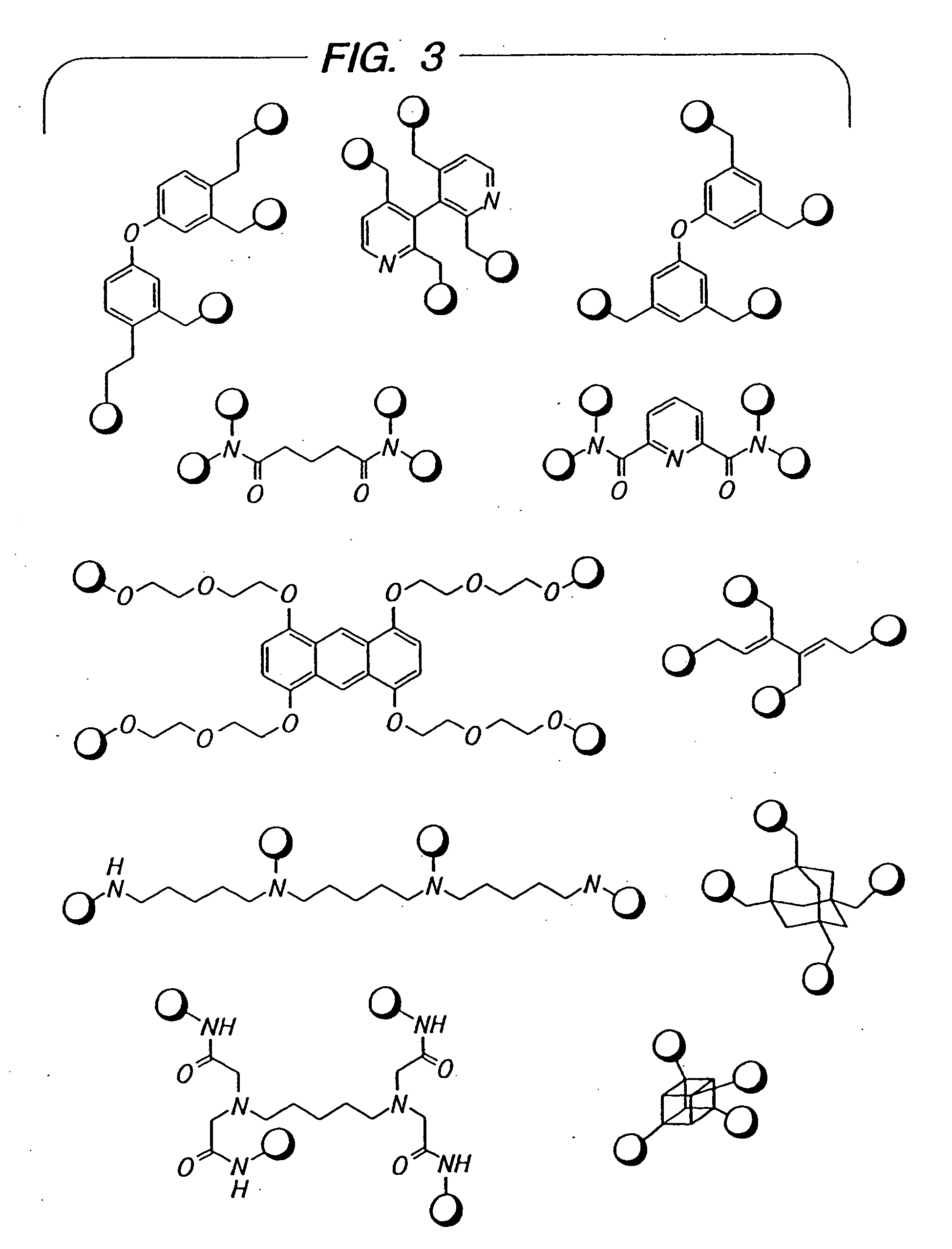Novel antibacterial agents
a technology of antibacterial agents and multi-binding compounds, which is applied in the direction of drug compositions, peptides, peptides/protein ingredients, etc., can solve the problems of affecting the effectiveness of antibacterial agents, interfering with the penultimate step in the synthesis of bacterial cell walls, and cell lysis, so as to achieve rapid and efficient evaluation
- Summary
- Abstract
- Description
- Claims
- Application Information
AI Technical Summary
Benefits of technology
Problems solved by technology
Method used
Image
Examples
example 11
Synthesis of Carbapenem-Amoxicillin Heterodimer (Following FIG. 21)
Step 1
[0398]A solution of compound 44 (10 mmols) in THF (10 mL) is treated with Boc anhydride (11 mmols) and after 1 hr. the volatiles are removed under vacuum to afford intermediate 45.
Step 2
[0399]A solution of compound 46 (2 mmols) in acetonitrile ((10 mL) is treated with a solution of intermediate 45 (2 mmols) and N-ethyldiisopropylamine (11 mmols) in anhydrous DMF (10 mL) and the reaction stirred at 0° C. for 1 hour. The solvents are removed in vacuo and the crude product is purified by HPLC to afford compound 47.
Step 3
[0400]A solution of commercially available Cefoclor 48 (20 mmols) in THF (25 mL) is treated with Boc anhydride (22 mmols). After 1 hour of p-nitrobenzyl alcohol (22 mmols) is added followed by dicyclohexylcarbodiimide (22 mmols). When complete as indicated by HPLC, trifluoroacetic acid (1 mL) is added and when removal of the Boc group is complete the reaction is filtered and the solvent removed. Th...
example 12
Synthesis of Ceftazidime Homodimer (Following FIG. 22)
Step 1
[0403]To chloromethylcephalosporonic acid chloride 52 (32.0 g, 74 mmol) in a 1:1 mixture of acetonitrile and dimethylformamide (300 mL) was added compound 53 (36.9, 156 mmol). After 4 h, the crude product was precipitated by diluting the solution with ether (800 mL). The solid was filtered and purified by reverse phase HPLC to give compound 54.
Step 2
[0404]A mixture of compound 54 (7.1 g, 9.5 mmol) and anisole (3 mL) in trifluoroacetic acid (30 mL) was stirred for 20 min. The desired product 55 was precipitated out by diluting the solution with ether (600 mL), then filtered and dried.
Step 3
[0405]To a solution of hexadecanedioic acid (12 mg, 0.05 mmol) in dimethylformamide (0.3 mL) was added HATU (40 mg, 0.11 mmol). After 1 h, compound 55 (75 mg, 0.10 mmol) was added and stirring was continued. After 4 h, 0.5% aqueous trifluoroacetic acid (0.5 mL) was added and the reaction mixture was purified by reverse phase HPLC to give t...
example 13
Synthesis of Cefoperazone Homodimer (Following FIG. 23)
Step 1
[0406]To a solution of cefoperazone sodium salt (10.0 g) in water (100 mL) was added 6 N hydrochloric acid until the pH of the solution was approximately 2. The white precipitates were filtered off to give compound 57.
Step 2
[0407]Compound 57 (1.1 g, 1.71 mmol) and sodium bicarbonate (0.16 g, 1.88 mmol) were combined and then a solution of p-methoxybenzyl bromide (0.51 g, 2.56 mmol) in dimethylformamide / dioxane (5 ml / 3 ml) was added. The reaction mixture was allowed to stir overnight and then concentrated. Ethyl acetate was added and the organic layer was washed with saturated sodium bicarbonate, brine, dried over magnesium sulfate and filtered. The filtrate was concentrated to give compound 58.
Step 3
[0408]To a solution of compound 58 (21.8 mg, 28.5 mmol) in acetonitrile (145 mL) was added diisopropylethylamine (5.96 mL, 34.2 mmol), followed by p-nitrophenyl chloroformate (5.8 g, 34.2 mmol). After 1 h, the reaction mixture ...
PUM
| Property | Measurement | Unit |
|---|---|---|
| weight percent | aaaaa | aaaaa |
| weight percent | aaaaa | aaaaa |
| pH | aaaaa | aaaaa |
Abstract
Description
Claims
Application Information
 Login to View More
Login to View More - R&D
- Intellectual Property
- Life Sciences
- Materials
- Tech Scout
- Unparalleled Data Quality
- Higher Quality Content
- 60% Fewer Hallucinations
Browse by: Latest US Patents, China's latest patents, Technical Efficacy Thesaurus, Application Domain, Technology Topic, Popular Technical Reports.
© 2025 PatSnap. All rights reserved.Legal|Privacy policy|Modern Slavery Act Transparency Statement|Sitemap|About US| Contact US: help@patsnap.com



